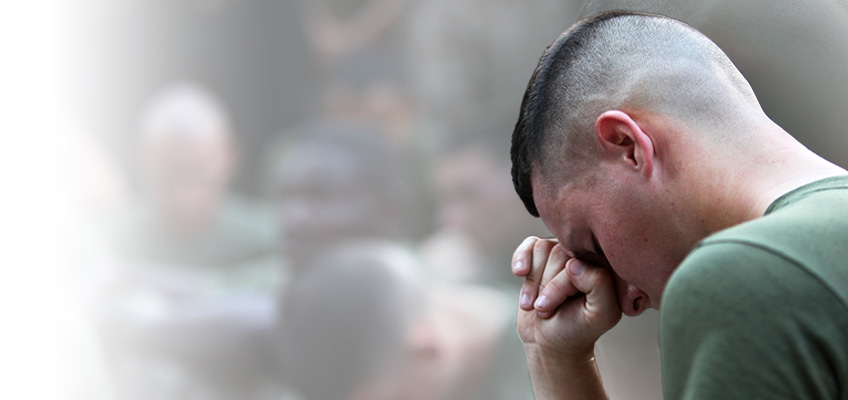
PTSD May Be Greatest Injury of War Today
From time immemorial, war has exacted a huge emotional toll on its participants. Although our understanding of the psychological impact of warfare has increased greatly over the past century and methods for treating combat-related psychological illnesses have become increasingly sophisticated, American troops on the front lines of the war in Iraq and Afghanistan are in many ways like the Greek hero Theseus trying to slay the Minotaur as they look for a way out of the labyrinth of psychological challenges they face.
That labyrinth has grown both in size and complexity during the war on terror. According to a growing body of research, including the Rand study, Invisible Wounds of War, more than a quarter of the 1.64 million troops deployed in Iraq and Afghanistan have significant mental health challenges: “Early evidence suggests that the psychological toll of these deployments – many involving prolonged exposure to combat-related stress over multiple rotations – may be disproportionately high compared with the physical injuries of combat,” the report states.
PTSD Most Common Combat Disorder
The most commonly identified psychological clinical disorder stemming from the war is post-traumatic stress disorder (PTSD), and a more general category that affects a higher percentage of combat troops is now known as combat operations stress reactions (COSR), which includes such symptoms as hypervigilance, hyperarousal, sleep disturbance, nightmares, mood disturbance, irritability, memory and concentration problems. Left untreated, such symptoms lead to more serious problems like clinical depression, substance abuse, violence and suicide. Recently, two advocacy groups for U.S. Veterans – Veterans for Common Sense and Veterans United for Truth – filed a federal lawsuit in San Francisco that cited an epidemic of suicides among veterans. According to a report in December 2007 by Brig. Gen. Michael J. Kussman, undersecretary for health at the Veterans Administration, an estimated 18 soldiers commit suicide each day, a figure substantially higher than those killed in combat.
Key findings of Invisible Wounds of War include:
- Current rates of exposure to combat trauma and mental health conditions among returning veterans are relatively high.
- Some groups are at a higher risk for these conditions.
- There is a large gap in care for these disorders: The need for treatment is high, but few receive adequate services.
- PTSD, major depression and TBI (traumatic brain injury) can have long-term, cascading consequences.
The psychological cost of this war stems from a number of factors, some primitive and others highly advanced. For example, conventional explosives with a simple detonating mechanism have caused 40% of military deaths and a very high percentage of the injuries in Iraq and Afghanistan. This explains why seeing a comrade killed or wounded is the highest-ranked exposure-to-trauma category currently reported by combat soldiers. At the same time, significant advances in surgery and related medical practices, as well as advances in medical technology have saved many lives that would have been lost under previous battle conditions. The increase in survivors, however, has resulted in psychological disorders in a greater percentage of returning soldiers.
Addressing the psychological needs of soldiers returning from combat is challenging the knowledge, skills and resources of civilian and military mental health specialists. Although there are a number of initiatives under way to address the problem, there is no consensus on which best addresses the problem.
Although most service members return home from war without long-term problems and readjust successfully, the majority have significant short-term challenges and exhibit one or more of the symptoms of COSR. Finding the most effective solutions to ease these reintegration challenges is a matter of national urgency, one that requires commitment at the highest levels of government, cooperation of military and civilian mental health practitioners, ingenuity, imagination and even boldness.
Innovative Program Can Help in PTSD/COSR Patients
As the Veterans Administration (VA) expands the number and scope of specialized mental health programs to improve veterans’ access to care and services and treatment outcomes, innovative and promising interventions such as HeartMath’s heart-rate-variability coherence biofeedback (HRVCB) training can prove highly beneficial in ameliorating PTSD and COSR. The time to explore promising new interventions is now, while the majority of new combatants are recently returned from deployment or even still in uniform. Proactive program development can help providers take action before clinical symptoms take root.
Although veterans’ needs and the demand for treatment are on the rise, many barriers to successful outcomes exist. Veterans’ ambivalence about entering and remaining in VA treatment programs may stem in part from poor response to current treatments. Programs that require a specially trained physician may face a workforce shortage that could further compromise the services the VA provides.
HRVCB training can be a significant addition to existing PTSD treatments: It can deliver benefits to veterans effectively, safely and perhaps most important, quickly. HRVCB has provided immediate relief in many cases. Heart-rate-variability coherence biofeedback (HRVCB), which has been used successfully in a variety of other clinical settings involving stress and anxiety, provides tools to achieve autonomic balancing, emotional restructuring and psychophysiological coherence.
In an HRVCB training program, the participant learns to self-regulate heart-rate variability (HRV) by associating it with a positive emotional state, and then voluntarily produces the emotional state that increases coherence. The usual course of HRVCB training is about eight training sessions. HRVCB utilizes the emWave® Pro PC/Mac’s to monitor and display individuals’ HRV patterns in real time. Visual feedback of HRV is provided as participants practice techniques of heart-focused breathing, along with the induction of a positive emotional state.
Support for developing innovative methods for treating combat-related PTSD is very high as the Department of Defense continues to fund high-impact projects and attract top clinicians and researchers. As new guidelines for traumatic stress treatment are put forth, a comprehensive database of responses to treatment can be created and used to develop still better treatments in the future.
Jack Ginsberg, an investigator and clinical assistant professor in the department of neuropsychiatry and behavioral science at the VA’s Dorn Medical Center, and his team there have obtained data that documented the relationship between HRV and cognitive outcome variables such as attention and immediate memory. There is significant evidence indicating the association between vagal tone and heart-rate variability (HRV), as well as attentional processes and HRV; the research has set appropriate and feasible goals that will make use of this approach for enhancing the care and outcomes for veterans with PTSD and COSR. Read the abstract for Improving Cognition in Recently Returned Combat Veterans with Post-traumatic Stress Disorder by Heart Rate Variability Coherence Biofeedback.
HRVCB is an accepted therapeutic technique that has achieved near-immediate improvements in HRV in patients with anxiety or anger problems, coronary diseases and in healthy patients exposed to stress. The improvements in thinking and memory in post-war veterans would directly impact the lives of their caregivers, families and indirectly, the American public. The potential long-term impact is that future researchers could operate from a foundation of established correlations between HRV, attention and memory, and PTSD. Moreover, they could build on these findings to further investigate the viability of HRV biofeedback as treatment for numerous other consequences of PTSD, including depression, sleep disruption, regulation of abnormal circadian patterns and major medical disorders such as heart disease.
The participant learns in the HeartMath training program to self-regulate heart-rate variability, producing a positive emotional state that increases HRV. The usual course of HRVCB training is about eight training sessions. HRVCB is an interactive procedure using a hardware/software system to monitor and display individuals’ HRV patterns in real time. Visual feedback of HRV (through either quantitative display or animated challenge games) is provided as participants practice techniques of attention focusing, controlled breathing and achieving a positive emotional state.
HeartMath heart-rate-variability coherence biofeedback training skills can be taught to soldiers via phone instruction and counseling in the privacy of their own homes. Learn about applying for and contributing to the HeartMath Military Service Appreciation Initiative, which provides aid for lessening mental, emotional and physical suffering to soldiers before deployment and during reintegration from combat zones to cope with the effects of war.
The Invisible Wounds of War found that “the effects of post-combat mental health and cognitive conditions can be compared to ripples spreading outward on a pond. However, whereas ripples diminish over time, the consequences of mental health conditions may grow more severe, especially if left untreated.” The report amplifies this point by suggesting that those afflicted with these conditions “have higher rates of unhealthy behaviors, physical health problems and mortality” and are more likely to be unemployed and homeless. It also notes: “Suffering from these conditions can also impair personal relationships, disrupt marriages, aggravate difficulties with parenting, and cause problems in children that extend the costs of combat experiences across generations.”
HeartMath heart-rate-variability coherence biofeedback training skills can be taught to soldiers via phone instruction and counseling in the privacy of their own homes. Learn about applying to the HeartMath Military Service Appreciation Initiative which provides aid for lessening mental, emotional and physical suffering to soldiers before deployment and during reintegration from combat zones to cope with the effects of war. Support our veterans and military personal.
Learn about the Free Resources for Veterans, Service Members & Their Families including the HeartMath Education and Resilience Training (H.E.A.R.T.) DVD and Booklet, a five-hour program, free for military service members, veterans and spouses, incorporates research-based self-regulation techniques and technology.

